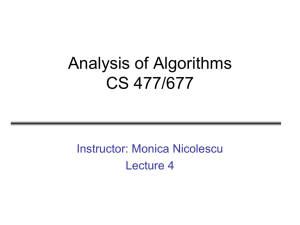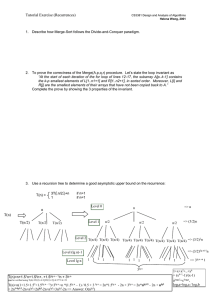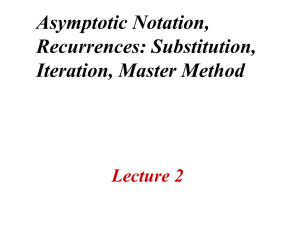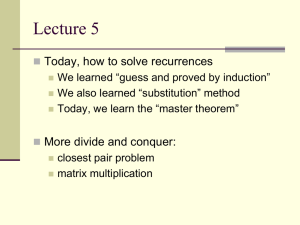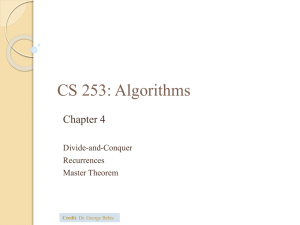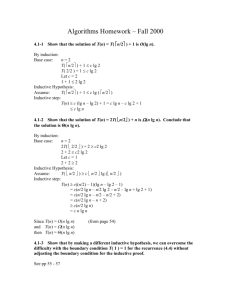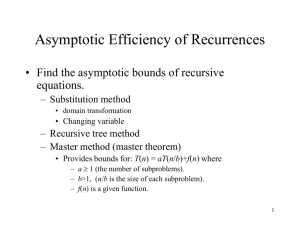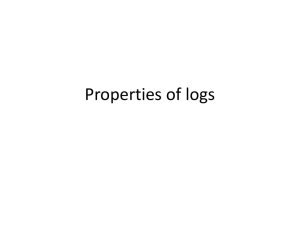Solving recurrences
advertisement
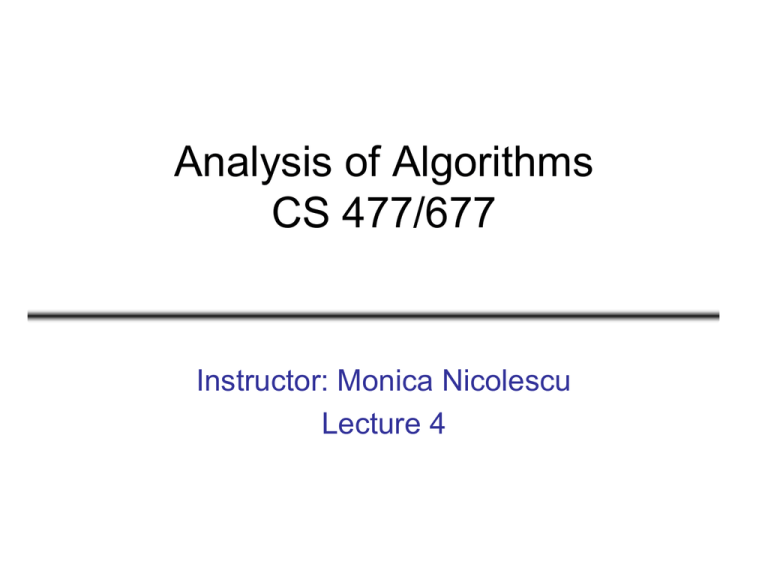
Analysis of Algorithms CS 477/677 Instructor: Monica Nicolescu Lecture 4 Methods for Solving Recurrences • Iteration method • Substitution method • Recursion tree method • Master method CS 477/677 - Lecture 4 2 The recursion-tree method Convert the recurrence into a tree: – Each node represents the cost incurred at that level of recursion – Sum up the costs of all levels Used to “guess” a solution for the recurrence CS 477/677 - Lecture 4 3 Example 1 W(n) = 2W(n/2) + n2 • • • • Subproblem size at level i is: n/2i Subproblem size hits 1 when 1 = n/2i i = lgn Cost of the problem at level i = (n/2i)2 No. of nodes at level i = 2i i i lg n 1 2 lg n 1 Total cost: n 1 1 1 lg n 2 2 2 W ( n) 2 i 0 W(n) = O(n2) i 2 W (1) n 2 nn i 0 CS 477/677 - Lecture 4 2 i 0 O(n) n 1 1 O ( n) 2 n 2 2 4 Example 2 E.g.: T(n) = 3T(n/4) + cn2 • • • • • Subproblem size at level i is: n/4i Subproblem size hits 1 when 1 = n/4i i = log4n Cost of a node at level i = c(n/4i)2 Number of nodes at level i = 3i last level has 3log4n = nlog43 nodes Total cost: T ( n) log4 n 1 i 0 i i 1 3 2 3 log 4 3 cn2 O n log4 3 cn2 O n log4 3 O(n 2 ) cn O n 3 16 i 0 16 1 16 CS 477/677 - Lecture 4 5 2 T(n) = O(n ) Example 2 - Substitution T(n) = 3T(n/4) + cn2 • Guess: T(n) = O(n2) – Induction goal: T(n) ≤ dn2, for some d and n ≥ n0 – Induction hypothesis: T(n/4) ≤ d (n/4)2 • Proof of induction goal: T(n) = 3T(n/4) + cn2 ≤ 3d (n/4)2 + cn2 = (3/16) d n2 + cn2 = d n2 + cn2 + (3/16) d n2 - d n2 = d n2 + cn2 - (13/16) d n2 ≤ d n2 if: cn2 - (13/16) d n2 ≤ 0 d ≥ (16/13)c Therefore: T(n) = O(n2) CS 477/677 - Lecture 4 6 Example 3 W(n) = W(n/3) + W(2n/3) + n • The longest path from the root to a leaf is: n (2/3)n (2/3)2 n … 1 • Subproblem size hits 1 when 1 = (2/3)in i=log3/2n • Cost of the problem at level i = n • Total cost: W (n) n n ... for all levels log3 / 2 n log3 / 2 n i 0 i 0 n n 1 n log3 / 2 n n CS 477/677 - Lecture 4 W(n) = O(nlgn) lg n 1 n lg n lg 3 / 2 lg 3 / 2 7 Example 3 - Substitution W(n) = W(n/3) + W(2n/3) + n • Guess: W(n) = O(nlgn) – Induction goal: W(n) ≤ dnlgn, for some d and n ≥ n0 – Induction hypothesis: W(k) ≤ d klgk (n/3, 2n/3) for any k < n • Proof of induction goal: Try it out as an exercise!! CS 477/677 - Lecture 4 8 Master’s method • “Cookbook” for solving recurrences of the form: n T (n) aT f (n) b where, a ≥ 1, b > 1, and f(n) > 0 Idea: compare f(n) with nlogba • f(n) is asymptotically smaller or larger than nlogba by a polynomial factor n • f(n) is asymptotically equal with nlogba CS 477/677 - Lecture 4 9 Master’s method • “Cookbook” for solving recurrences of the form: n T (n) aT f (n) b where, a ≥ 1, b > 1, and f(n) > 0 Case 1: if f(n) = O(nlogba -) for some > 0, then: T(n) = (nlogba) Case 2: if f(n) = (nlogba), then: T(n) = (nlogba lgn) Case 3: if f(n) = (nlogba +) for some > 0, and if af(n/b) ≤ cf(n) for some c < 1 and all sufficiently large n, then: T(n) = (f(n)) regularity condition CS 477/677 - Lecture 4 10 Why nlogba? • Case 1: n T (n) aT b n a 2T 2 b n a 3T 3 b – If f(n) is dominated by nlogba: • T(n) = (nlogbn) • Case 3: – If f(n) dominates nlogba: n T (n) a iT i i b • T(n) = (f(n)) • Case 2: • Assume n = bk k = logbn – If f(n) = (nlogba): • T(n) = (nlogba logn) • At the end of iterations, i = k: T ( n) a n T (n) aT f (n) b bi T i a logb nT (1) a logb n n logb a b logb n CS 477/677 - Lecture 4 11 Examples T(n) = 2T(n/2) + n a = 2, b = 2, log22 = 1 Compare nlog22 with f(n) = n f(n) = (n) Case 2 T(n) = (nlgn) CS 477/677 - Lecture 4 12 Examples T(n) = 2T(n/2) + n2 a = 2, b = 2, log22 = 1 Compare n with f(n) = n2 f(n) = (n1+) Case 3 verify regularity cond. a f(n/b) ≤ c f(n) 2 n2/4 ≤ c n2 c = ½ is a solution (c<1) T(n) = (n2) CS 477/677 - Lecture 4 13 Examples (cont.) T(n) = 2T(n/2) + n a = 2, b = 2, log22 = 1 Compare n with f(n) = n1/2 f(n) = O(n1-) Case 1 T(n) = (n) CS 477/677 - Lecture 4 14 Examples T(n) = 3T(n/4) + nlgn a = 3, b = 4, log43 = 0.793 Compare n0.793 with f(n) = nlgn f(n) = (nlog43+) Case 3 Check regularity condition: 3(n/4)lg(n/4) ≤ (3/4)nlgn = c f(n), c=3/4 T(n) = (nlgn) CS 477/677 - Lecture 4 15 Examples T(n) = 2T(n/2) + nlgn a = 2, b = 2, log22 = 1 • Compare n with f(n) = nlgn – seems like case 3 should apply • f(n) must be polynomially larger by a factor of n • In this case it is only larger by a factor of lgn CS 477/677 - Lecture 4 16 Readings • Chapter 2 CS 477/677 - Lecture 4 17
